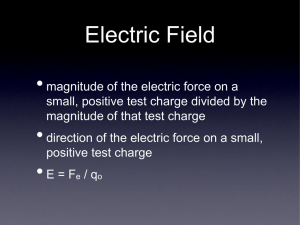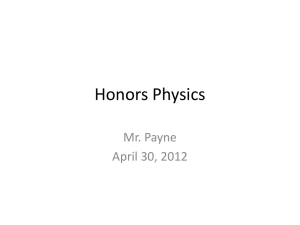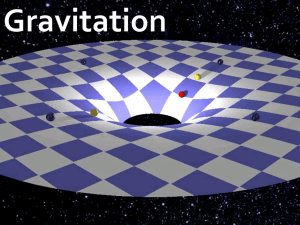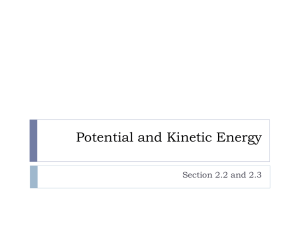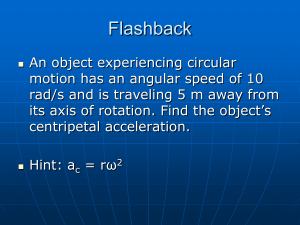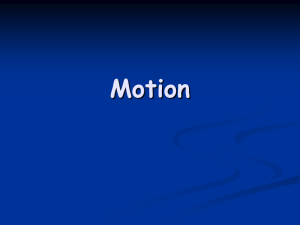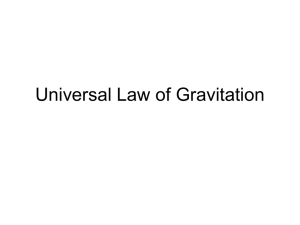3-Newton`s law of gravity قانون نيوتن للثقالة
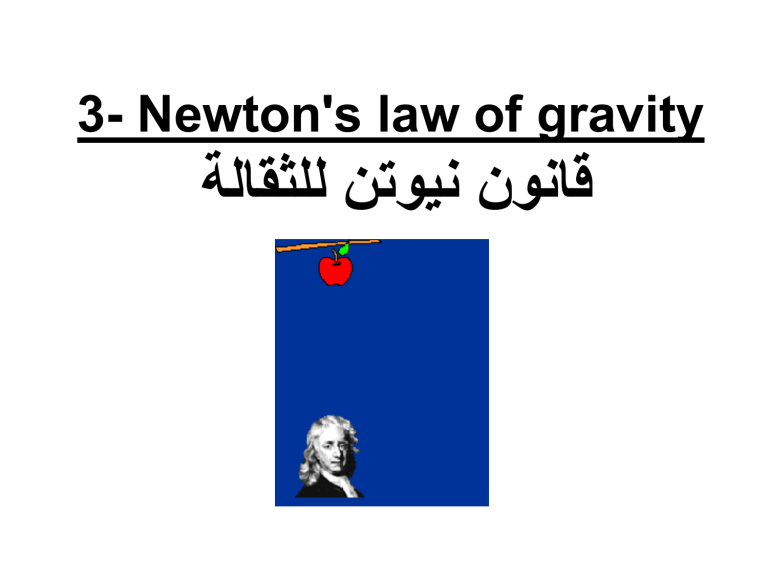
3- Newton's law of gravity
ةلاقثلل نتوين نوناق
Galileo Galilei
(1564-1641)
Using a telescope he made, Galileo observed:
Moons of Jupiter.
Phases of Venus.
His findings supported a Copernican model.
He spent the end of his life under “house arrest” for his beliefs.
Johannes Kepler
German astronomer (1571 –1630)
Kepler has try to deduce a mathematical model for the motion of the planets.
Isaac Newton (1642-1727).
• " Every particle in the Universe attracts every other particle with a force that is directly proportional to the product of their masses and inversely proportional to the square of the distance between them ".
مي سج يأ بذجي نوكلا يف ميسج يأ
عم ًايدرط بسانتت ةوقب رخآ
ايس كع بسانتتو امهيتلتك بورضم
.
امهنيب اميف ةفاسملا عبرم عم
•
If the particles have masses m
1 and m
2 and are separated by a distance r, the magnitude of this gravitational force is: m
2
و m
1
ناميسجلا ةلتك تناك اذإ
نإف ، r ةفاسم امهلاصفي ناكو
: نوكي لقاثتلا ةوق رادقم
F
g
G m
1 r 2 m
2
• where G is a universal constant called the universal gravitational constant which has been measured experimentally.
• The value of G depends on the system of units used, its value in SI units is:
.
ًايل معم ساقم وهو ماعلا لقاثتلا تباث ىمسي ماع تباث
يف هتميقو ةمدختسملا تادحولا ماظن ىلع G
G ثيح
ةميق دمتعت
: يلودلا ماظنلا
G = 6.672 x 10-11 N. m2 / kg2
• The force law is an: inverse-square law
يسكعلا عيبرتلا نوناق because the magnitude of the force varies as the inverse square of the separation of the particles.
• We can express this force in vector form يهاجتا لكش by defining a unit vector r
12
ةدحولا هجتم
• Because this unit vector is in the direction of the displacement vector r
12 directed from m1 to m
2
, the force exerted on m
2
, by m
1 is :
F
21
= - (G ( m
1 m
2
) / r
12
2 ) r
12
• Likewise, by Newton's third law the force exerted on m
1 by m
2
, designated F
12
, is equal in magnitude to F
21 and in the opposite direction.
• That is these forces form an actionreaction pair لعفلا درو لعفلا ىوق نم جوز
F
12
= F
21
• the gravitational force exerted by a finite-size, spherically symmetric mass distribution on a particle outside the sphere is the same as if the entire mass of the sphere were concentrated at its center
ةركلا ةلتك نأ ول امك ىوقلا لمعت
.
اهزكرم يف ةزكرم
•
• For example, the force exerted by the
Earth on a particle of mass m at the
Earth's surface has the magnitude
Fg = G ( m
E m ) / R
E
2 m
E is the Earth's mass ضرلأا ةلتك and
R
E is the Earth's radius ضرلأا رطق فصن
• This force is directed toward the center of the Earth
ضرلأا زكرم وحن ةهجوم
• At points inside the earth:
We would find that the force decreases as we approach the center.
Exactly at the center the gravitational force on a body would be zero.
4-Measurement of the gravitational constant
ماعلا لقاثتلا تباث سايق
The universal gravitational constant, G, was measured by Henry Cavendish in 1798
5- Weight and gravitational force
لقاثتلا ةوقو نزولا
If g is the magnitude of the free-fall acceleration, and since the force on a freely falling body of mass m near the surface of the Earth is given by
F = m g, we can equate m g = G ( m
E m / R
E
2 )
g
G m
E
R 2
E
Using the facts that g = 9.80 m/s2 at the Earth's surface and R
E
= 6.38 x
10 )6( m, we find that m
E
= 5.98 x 10 )24( kg.
• From this result, the average density of the Earth is calculated to be :
•
• ρ
E
= m
E
/ V
E
= m
E
/ ( 4/3 π R
E
3 )
/
)3
= 5.98 x 10 24
( 4/3 π 6.38 x 106 m
= 5500 kg/m3 = 5.5 g/cm3
• Since this value is higher than the density of most rocks at the
Earth's surface (density of granite =
هل
3 g/cm3 ),
• we conclude that the inner core of the Earth has a density much higher than the average value.
ةف اثك نم ىلعأ اهتميق ةفاثكلا كلت نأ امب
اننإف ضرلأا ىلع ةيرخصلا داوملا مظعم
ضرلأل يلخادلا بلقلا نأ كلذ نم جتنتسن
ةفاثكل ةطسوتملا ةميقلا نم ىلعأ ةفاثك
.
ضرلأا
•
• The magnitude of the gravitational force acting on this mass is:
• Fg = G ( M
E m / r2 )
= G ( M
E m / ( R
E
+ h )2 )
• If the body is in free-fall, then
Fg = mg' and we see that g', the freefall acceleration experienced by an object at the altitude h, is g' = G m
E
/ r2
= G m
E
/ ( R
E
+ h ) 2
• Thus, it follows that g' decreases with increasing altitude املك ةيبذاجلا ةلجع لقت
ضرلأا حطس نع انعفترا .
• Since the true weight of an object is mg , we see that as r →∞, the true weight approaches zero.
6- The Gravitational Field لاجم
لقاثتلا
• When a particle of mass m is placed at a point where the field is the vector g, the particle experiences a force
Fg = m g.
• the gravitational field is defined by : g = Fg / m
• consider an object of mass m near the Earth's surface.
The gravitational force on the object is directed toward the center of the Earth and has a magnitude (m g).
• Since the gravitational force on the object has a magnitude :
(G m
E m) / r2
g
F g m field g is
G r 2 m
E where r is a unit vector pointing radially outward from the Earth, and the minus sign indicates that the field points toward the center of the Earth and is always opposite to r r
• We have used the same symbol
زمرلا سفن g for gravitational field magnitude that we used earlier for the acceleration of free fall.
The units of the two quantities are the same تادحولا سفن امهل ناتيمكلا
.
Example
• A ring-shaped body with radius a has total mass M. Find the gravitational field at point p, at a distance x from the center of the ring, along the line through the center and perpendicular to the plane of the ring.
• We imagine the ring as being divided into small segments Δs, each with mass ΔM. At point P each segment produces a gravitational field Δg with magnitude.
•
•
• Δg = )G ΔM( / r2 = )G ΔM( / )x2 + a2)
• The component of this field along the xaxis is given by : Δg x
= Δg cosφ =
• - G ΔM . x
• x2 + a2 (x2 + a2( ½
= G ΔM x
(x2 + a2)3/2
• we simply sum all the ΔM 's.
This sum is equal to the total mass M.
g x
G
( x 2
M a 2 x
)
3
2
7-Gravitatiuonal Potential energy ةيبذاجلل عضولا ةقاط
• we know that the earth's gravitational force on a body of mass m, at any point outside the earth, is given by
• w = fg = (G m m
E
) / r2
We compute the work W grav done by the gravitational force when r changes from r
1 to r
2
W grav
r
2 r
1
F r dr
Thus W grav is given by:
W grav
G m m
E r
2 r
1 dr r 2
G m m
E r
2
G m m
E r
1
• W grav
= U
1
- U
2 where U
1 and U
2 are the potential energies of positions 1 and 2 . So Comparing this with the eq. of Wgrav gives:
U
G m m
E r
8- Kepler's laws رلبك نيناوق
•The complete analysis is summarized in three statements, known as Kepler's laws:
• l . All planets move in elliptical orbits with the Sun at one of the focal points. تارادم يف كرحتت بكاوكلا لك
.
هيترؤب ىدحإ يف سمشلا عقت صقان عطق لكش ىلع
• 2 . The radius vector drawn from the Sun to a planet sweeps out equal areas in equal time intervals.
ح سمي ام بكوك و سمشلا نيب ام طوطخملا يرطقلا هجتملا
.
ةيواستم ةنمزأ يف ةيواستم تاحاسم
•
• 3 . The square of the orbital period of any planet is proportional the cube of the semi major axis of the elliptical orbit.
بعكم عم بسانتي بكوك يلأ يرودلا نمزلا عبر
.
صقان عطق لكش ىلع يذلا رادملل يقفلأا روحملا
•
